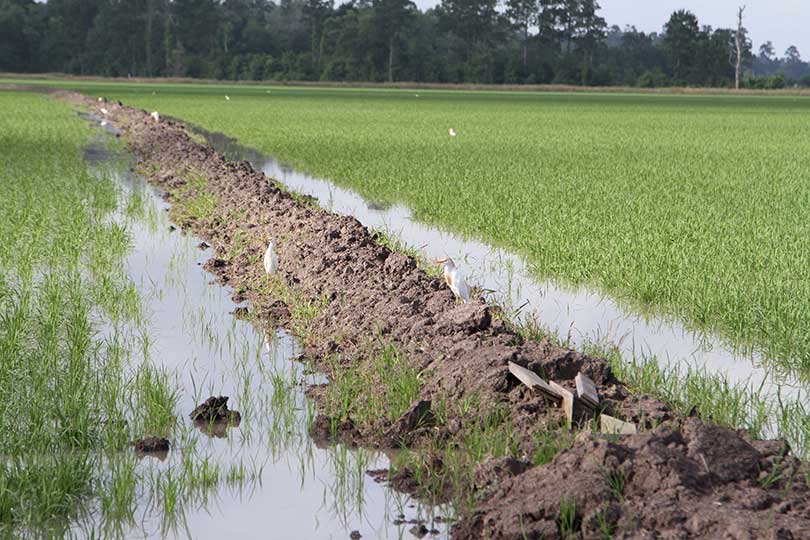By Jessica Domel
News Editor
Water from the Highland Lakes is once again making the trek down the Colorado River to Texas rice farms.
For the first time since May 2010, the Highland Lakes in Austin are full. That’s good news for Texas rice farmers in Wharton, Matagorda and Colorado counties who are now able to pump water from the lakes through the Colorado River to irrigate their fields.
“We started pumping water out of the canal around the 20th of March,” Paul Sliva, a Matagorda County rice farmer and county Farm Bureau board member, said. “There was quite a bit of water delivered for those first couple of weeks.”
That water, combined with several inches of rainfall, has led to wet fields for Sliva, which can be good for rice, provided it isn’t too wet.
“Finally I’m starting to dry out, but we really just need to dry out to help these plants grow. It’s not just the rice. The milo and corn is all saturated,” Sliva said.
Fortunately, Sliva’s area was not flooded when other parts of the state were inundated with water. The heavy rains, however, did damage some of his crop.
“I had some rice that wasn’t out of the ground when it started raining, and it had water on it for almost three weeks,” Sliva said. “It rotted some of that seed.”
As the weeks go on, the water from the Colorado River and Highland Lakes will be beneficial to rice farmers who have spent at least four years without water to grow their crop.
“You can’t dryland farm rice. Where I am in Matagorda County, there’s just not much available fresh groundwater,” Sliva said. “A lot of this land we cash lease is sandy, and it’s only good for rice. Without having water and without being able to farm rice, your farm and other crops eight out of 10 years aren’t going to make much.”
Four years without water wasn’t easy. That time without a successful rice crop for many took its toll on farmers and supporting industries, causing several businesses to close their doors or consolidate.
“The majority of the land down here is sandy,” Sliva said. “We tried other crops. Some years we did okay and some years we didn’t. It just depended on the rainfall we got.”
Now, four years later, Sliva and other rice farmers along the river are thankful to once again have access to water to grow their crops.
Farmers in Colorado County also welcomed the water.
Rice farmer Tom Kelley explains river water is cheaper than well water, but that doesn’t mean farmers will rely solely on it.
In the years without river water, farmers in Colorado County spent thousands of dollars to drill wells for their rice and will likely continue to use them in addition to river water.
According to the Lower Colorado River Authority (LCRA), which manages the water in lakes Travis and Buchanan, the combined storage of the lakes on March 1 was 90 percent full.
Under LCRA’s new water management plan, those conditions mean up to 202,000 acre-feet of interruptible stored water from the lakes is available for diversion for downstream agriculture.
Following heavy rains and flooding in mid-April, the lakes rose to 100 percent full, which prompted LCRA to open the gates on Mansfield Dam for the first time in years.
That bodes well for farmers who look to a July 1 determination from LCRA as to whether or not water will be allocated for a second rice crop.
“Thankfully, with as much water as we’ve had, we’re going to get a second crop water that we need,” Sliva said. “We’ll all get second crop water because the lakes are full, and they aren’t going anywhere anytime soon.”
Current lake levels should mean that irrigation water from the lakes is available to rice farmers in the coming years. But State Climatologist John Nielsen-Gammon reports the emergence of a La Niña weather pattern, which typically brings drier weather to Texas.
The water Texas rice farmers receive from the Highland Lakes via the Colorado River is not free.
According to LCRA, interruptible customers like farmers pay a lesser rate than cities and industries because they risk not receiving the water in severe drought, which was the case from 2012-2015.
In 2015, the Texas Commission on Environmental Quality approved a new water management plan for LCRA, which sets the March 1 and July 1 dates for determining the amount of water interruptible customers, like rice

